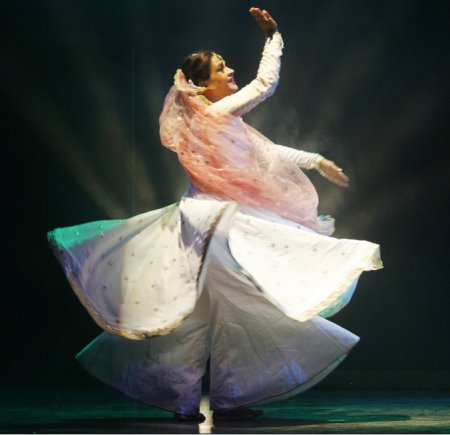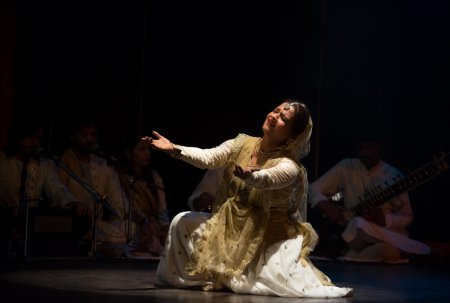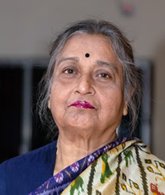
|   |

|   |
Noor - An evening of a divine experience - Dr.Nita Vidyarthi e-mail: nitavidyarthi@gmail.com Photos courtesy: Suman Sarawgi March 6, 2023 From the roof-top of a high-rise, Sparsh Studio's offering this time to the open-air stage on the plush green lawn of a sprawling bungalow, was 'Noor' (light), an evening of Sufi Kathak by dancer Rani Khanam. The production organised under the supervision of well-known Manipuri dancer Suman Sarawgi was brought to a niche audience of Kolkata in association with Alka Jalan Foundation and Women's Study Group. This latest trend (if permitted to call it so) in extending the boundaries of the dance form, is perhaps an artiste's choice of a particular sahitya, theme or subject of dancing to the text or poetry involving Sufi philosophy and is appreciated for its artistic and performative value.  A distinguished Kathak dancer of the Lucknow gharana, trained under legendary Gurus, Rani's foray into Sufiana was inspired by her knowledge of Islamic verses and Sufi texts, Persian and Farsi poetry by famous poets, Qalams, Taarab music, Sufi music, legendary musicians, instrumentalists and Sufi dancers at various corners of the Islamic world from where permeated this culture to Kathak. And the audience got a taste of it apart from some stunning Kathak nritta (pure dance) pieces. The production was based on Indo-Persian compositions and those of great Sufi masters, Islamic verses, Sufi-folk and Qawwalis. Rani began her recital with an invocation to the Almighty "Allah Hu" - Shunya se pehley, Shunya ke baad, Tu tha, Tu hai, Tuhi rahega. Set to a traditional Sufi chant sung with a Qawwali flavour, thrumming resonances of the sarod of Sunando Mukherjee, thundering tabla of none other than the acclaimed Ustad Sabir Khan and the repetition of the word "Allah" from the powerful, full-throated singing of Zohaib Hasan and Shuheb Hasan, the involved dancer, with raised hands portrayed the love for the Almighty, while illustrating the lyrics of the poetry that everything is perishable and nothing (Shunya or Zero) will remain - only Tu (you) - except Allah. With the alaap and music followed by "Ye gamhe jahan na du ya magar tuhi tu.." and entry of Rani, the ambience was steeped with boundless spirituality and the audience was ready for realizing that art is profound. Being a follower of Chistiya Silsila, Rani Khanam made her impact with her very first piece! "Nami daanam," the next number in Qawwali style was based on a composition by Persian poet Khuwaza Usman Haroni. In Ajmer, it is referred to as Farsi Hazlo. The poet says, "I know not why I dance with pleasure seeing my beloved but I dance because 'You' are making me dance in front of God to the prayers of the cosmic world." "Nami daanam ke akhir chun dam-e-deedar mi raqsam (dance) deedar" and "Tere ishq mein nach raha hu" was adorned with several chakkars, the dancer revolving in ecstasy, as if in trance. The quivering hands complimented with the intensity of the impassionate facial expression in the line "Ek hath mein suraj ek hath mein chand" (With the sun on one hand and moon on the other) was opulent with mysticism but not over-designed. Once the musicians began to weave their web, the dancer transported the audience to deep rooted spiritually slanted philosophical lyrics (my feet is full of blood but still I dance) with a sense of devotion. Rani's movement was like being pulled to a point of release, floating way out again and then being pulled back once more to surrender to him.  "Zara kholo ji darwaza Maharaj" by Hazrat Moinuddin Chishti popularly known as 'Garib Nawaz' was very well received by the audience for the fine shades of the rhythmic fast paced music with lyrics in North Indian Brajbhasha. The delicate sways and elegant wavy movements of the hands in ebb and flow, like the sea, subject to tidal pulls with the modulation and harmonics, aroused a sense of loss in the dancing in the marvellous sound colour of "Zara kholo ji kewardia (door) Maharaj... Rakhni padegi bhakt ki laaj." It is a plea to the Divine Master to take her to a new paradise on earth through a spiritual path towards perfection, love and harmony to unite with the illuminated souls. And Rani Khanam's execution was a mesmerizing display of thought provoking act with an ethereal twist. With the similar description that reflect the impact of the essence which is distilled in devotional and emotional intensity in divine love in music and dance was "Tere ishq nachaya karkey thaiya thaiya" penned by one of the greatest Sindhi poets, Bulleh Shah. The lively number highlighting love for God (Your love has made me dance like mad) embellished with the routine chakkars spanning the stage was a hit on the first appearance and blended with music into a surprising, impressive mix, resulting in a precise and aesthetic form with its ascending and descending movement which consisted of either full octave or a series of six or seven notes. Some glimpses of Assamese Folk Sufi Music compositions in traditional Assamese tunes and language based on "Bhed-Bhav" (social discrimination) popularized by Azan Fakir, who came to stay in the land around 16th century were obtained in numbers that marked brotherhood like "Kahe karo bhed bhav... Mor mon bhed bhavna na aio Allah" (Let not my mind be influenced by discriminations) or "Ekhi hai wohi hai". Here there were images of working with potters or reference to boatman, or subtle protest for differentiating between boys and girls. Fakir's compositions conveyed the message of peace and harmony. For a section of the audience, the bouquet of scintillating Kathak nritta was a welcome shoot-up. Beginning with madhyalaya in teen taal and the naghma in raga Charukesi, gems of the Lucknow gharana were presented one after the other. Her concluding Jugalbandhi ending with steady chakkars with the thundering master strokes of Sabir Khan was a highly rewarding experience. Incidentally for the trained eyes, the intricacies, high precisions and fractions of rhythms displayed by the dancer in the footwork of some of the Sufi numbers were recognizable and a delight to savour. The recital of Sufi mysticism was a fine effort to elevate the audience, some with sparse knowledge of the Persian or Farsi language, to absorb the essence of the lyrics and the philosophy, even if partly, with the introductory explanations by the dancer before each item. The evening concluded with the familiar frequently heard vibrant Amir Khusroo number "Chaap tilak sab chhini re" which was greeted with a huge applause. The support on the dholak by Krishnendu Parikshit, flute by Rupak Mukherjee, lights by Ajay Ranu and sound by Soumitra Das was highly appreciated. Suman Sarawgi conducted the program with elan.  Dr. Nita Vidyarthi is a veteran critic of performing arts and writes on dance, music and theatre in leading publications. |